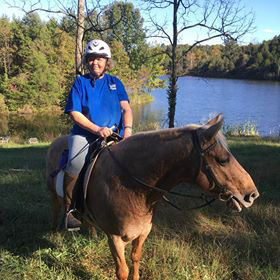Do you want to sit more balanced on your horse so you don’t give more weight to one side, hurting your horse’s back and confusing him? Do you want to learn how to synergistically engage the pelvic floor and other core muscles to keep your balance when your horse makes a sudden jig? Do you want to shift and flow with your horse’s movements fluidly and lightly? Then learning awareness and strength of your pelvic floor through the Feldenkrais Method in order to help develop an independent seat is for you.
What does the pelvic floor have to do with sitting on your horse? You probably know about the sitting bones and how they are the basis of your seat on the horse. The pelvic floor consists of muscles that attach to the sitting bones to each side, and then to the pubic bone at the front and the tail bone at the back. This sling of muscles defines the pelvic floor and is an integral part of your seat on the horse. The auxiliary muscles to the pelvic floor are the inner thigh muscles. The inner thigh muscles, known as the adductors, and other thigh muscles work in conjunction with the pelvic floor, like an extension of the pelvic floor. If you are looking for a ride where you have control and awareness of your whole self so that the horse, who is extremely sensitive, can feel your movement through your legs and body and will know exactly what you are communicating, as you rely firstly on natural aids and extend seamlessly into artificial ones, then learning to have an independent and differentiated pelvic floor is essential.
You may be asking, what do you mean by “differentiated”? Differentiation is the capacity to be aware and move various bones, muscles and parts of yourself independently from others parts. Developing this capacity is part of the basis of the Feldenkrais Method. Differentiation equals an independent seat. Through the Feldenkrais Method you become more aware of your body and yourself, you learn to use your senses. Then you may be surprised how the body begins to do what you want more easily! The Feldenkrais Method doesn’t just tell you WHAT to do, it guides you in the HOW to do it so that it becomes more second nature for you, as you use your senses and attention to guide you. It is only in this way that you can expect your horse to do what you want. Simply put, you have to know what you are doing before you can ask your horse to do anything!
In the Pelvic Floor Workshop for Women, in order to learn awareness and strength of the pelvic floor, we will do gentle exercises that begin with a whole full body movement and then layer in the pelvic floor, because this is the way we use the pelvic floor in real life, such as riding. Working with the Feldenkrais Method gives you a sense of the movement of your skeleton, and as Sally Swift states in her book Centered Riding “…the balance of one grouping of bones above another, all up and down the skeleton, must be correct to produce a balanced and coordinated rider. If the bones are in the right place, then the muscles need to do less work, resulting in fewer tensions.”
In addition to the exercises, in this workshop we will include an overview of the functions of the pelvic floor, including healthy voiding and continence.
If you have questions or would like to discuss more to see if this workshop is for you, I would be happy to talk with you. Come find out how the Feldenkrais Method can help you have an independent seat and a better ride!



Sally Swift is truly an icon in the horse world. In Louisville, we are lucky to have an outstanding certified Feldenkrais Practitioner, Dorothy Henning. Dorothy is going to be giving a riderless workshop on How to Develop an Independent Seat on February 9 & 10 in Louisville.
I rode with Sally Swift after her “Centered Riding” book first came out. Dorothy’s methods very much remind me of my clinics with Sally Swift. I have been going for individual & group sessions with Dorothy for the past year.
I have an arthritic hip that impacted my comfort, balance, straightness, and position. Thanks to Dorothy, I am riding better than ever. Dorothy is one of the best riding instructors I’ve ever had. Sometimes I feel like my horse is right in the office, sharing his insights with Dorothy as she works with me.
If you are stiff or tense, have some aches, are struggling with some position issues, would like to feel more relaxed, or want to understand your core & seat at a deep level, you might want to come to this workshop.
This quote from Sally Swift (Dressage Academy) reminds me so much of Dorothy & the Feldenkrais Method:
“Remember, the conversation between you and your horse must never be dull or inert. It should be, “Ask, receive, give. Ask, receive, give.” Ask with your body and legs; receive through your body into your hands; give primarily with the hands, but also with your body and legs, so that you can ask all over again, receive again and give again. The give is your thanks. If you don’t give, you must ask harder the next time, and even harder after that, until you end up with a dead or resistant horse.” –
Rather beneficial, looking forward to coming back.